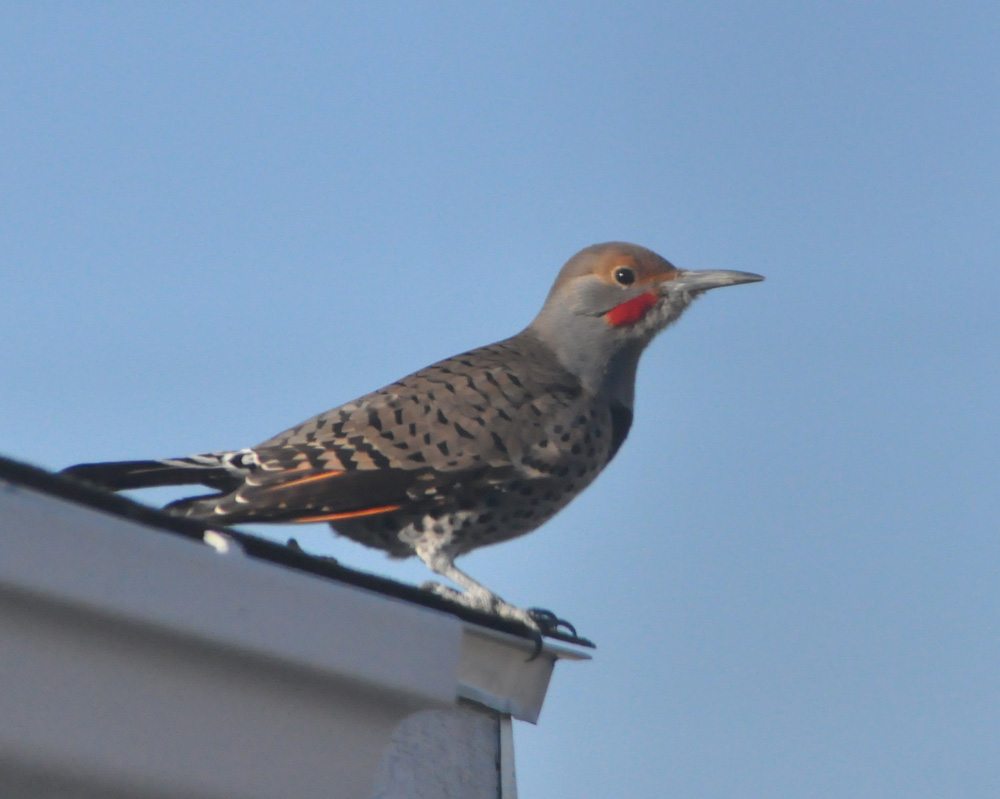
Flickers
The Red-shafted Flicker (Colaptes auratus cafer) resides in western North America and is a subspecies of the The Northern Flicker, which is part of the genus Colaptes, encompassing 12 New-World woodpeckers. There are two living and one extinct subspecies of C. auratus species. The existing sub-species were at one time considered separate species but they commonly interbreed where ranges overlap and are now considered one species by the American Ornithologists Union. The Red-shafted Flicker is sometimes called the Western Flicker by locals. They are red under the tail and underwings and have red shafts on their primaries. They have a beige cap and a grey face. Males have a red moustache. The scientific name, Colaptes auratus cafer, is the result of an error made in 1788 by the German systematist, Johann Gmelin, who believed that its original habitat was in South Africa among the Xhosa people, then known as the "Kaffir" people. (The term Kaffir is now considered an extreme ethnic slur in South Africa.) Although the Flicker is generally considered to be a migrating bird, the southern birds are often permanent residents.
Adults are brown with black bars on the back and wings. A mid-to-large-sized woodpecker, it measures 11–14 in length and 17–21 in wingspan. The body mass can vary from 3.0 to 5.9 oz. Anecklace-like black patch occupies the upper breast, while the lower breast and belly are beige with black spots. The tail is dark on top, transitioning to a white rump which is conspicuous in flight. This bird's call is a sustained laugh, ki ki ki ki, and one may also hear a constant knocking as they often drum on trees or even metal objects to declare territory. Like most woodpeckers, Northern Flickers drum on objects as a form of communication and territory defense. In such cases, the object is to make as loud a noise as possible, and that’s why woodpeckers sometimes drum on metal objects. One Northern Flicker in Wyoming could be heard drumming on an abandoned tractor from a half-mile away.
Flickers are the only woodpeckers that frequently feed on the ground, probing with their beak. Although they eat fruits, berries, seeds and nuts, their primary food is insects and they sometimes catch them in flight. Ants alone can make up 45% of their diet. Flickers often go after ants underground, where the nutritious larvae live, hammering at the soil the way other woodpeckers drill into wood. They have been observed breaking into cow patties to eat insects living within. Their tongues can dart out 2 inches beyond the end of the bill to snare prey.
Flickers may be obseved in open habitats near trees, including woodlands, edges, yards, and parks. In the western United States, one can find them in mountain forests all the way up to treeline. Northern Flickers generally nest in holes in trees like other woodpeckers. Both sexes help with nest excavation. The entrance hole is about 3 inches in diameter, and the cavity is 13-16 inches deep. The cavity widens at bottom to make room for eggs and the incubating adult. A typical clutch consists of 6 to 8 eggs whose shells are pure white with a smooth surface and high gloss. Incubations is by both sexes for approximately 11 to 12 days. Inside, the cavity is bare except for a bed of wood chips for the eggs and chicks to rest on. Once nestlings are about 17 days old, they begin clinging to the cavity wall rather than lying on the floor. The oldest yet known “red-shafted” Northern Flicker lived to be at least 8 years 9 months old.
 |
| Taken through the kitchen window, sitting on the corner of my garage. The Flickers have done a lot of damage to the siding on my house. |